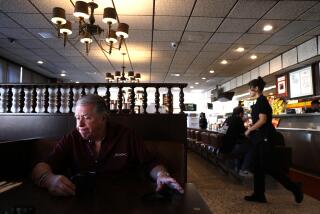Where goes the neighborhood?
The new year has begun without Larchmont Hardware, a small shop that opened its doors in 1925 in the middle of Larchmont Boulevard -- a two-block stretch between Beverly Boulevard and 1st Street known in the neighborhood simply as “the village.”
It was the sort of store that kept dog bones at the front counter for customers’ pets to chew on. Edwin, the clerk, was always happy to chitchat while you scrounged for a single bolt to buy. When Mario, the manager, died in a terrible accident last year, hundreds of Larchmont Hardware regulars showed up for his memorial service.
The hardware store isn’t the only establishment in the village to have been shuttered of late. In the last few months, the Italian restaurant La Luna, a photo shop and a realty office have gone away. Within the next month, Sam’s Bagels and a dry cleaner are expected to close. Across the street, a handful of other longtime retail tenants will soon be out of business too.
The turmoil is due in large part to a Westside developer, Albert Mizrahi, who has purchased four buildings on Larchmont -- and, according to local merchants, is eyeing more. He has asked current occupants to leave or has jacked up their rents so high that it is impossible for them to stay.
Meantime, rumors are flying. Mizrahi is getting set to build apartments, some say. Others contend that he’s planning to bring in major chain stores. Still others speculate that he wants to turn the shops on Larchmont into paparazzi magnets, a la the boutiques on Robertson Boulevard.
Mizrahi insists that he doesn’t have a grand vision for the village, save for wanting “to put in quality retail” for a “quality community.” “I can’t say what is going to come in there yet,” he said. “I’d like to update it -- put a little shine on the street -- and not change the overall character.”
But it’s precisely the boulevard’s overall character that we and many of our neighbors fear is being trampled.
Of course, it’s not as though Larchmont has stood perfectly frozen until now. Longtime residents recall when the boulevard boasted a grocery store, an independent pharmacy and a gas station. We’ve seen others come and go in our 12 years in the neighborhood.
What is particularly disconcerting now is that so much upheaval is happening so fast. In one sudden wave, we are witnessing a wiping away of the familiar, the wholesale violation of a space where we remember purchasing birthday gifts for each other, taking our children for ice cream on hot summer days, enjoying many an after-dinner stroll.
Apparently, we’re not alone in our feelings. “People are thinking with their hearts,” said Renee Weitzer, chief of staff for City Councilman Tom LaBonge, whose district includes Larchmont. “They don’t want to see change at all. They like the street the way it is. But that’s not realistic.”
LaBonge has introduced a measure that at least would impose height, width and setback standards on Larchmont, while ensuring that existing zoning restrictions remain intact. The idea is to keep a store with a large physical footprint, such as the Gap, from invading the boulevard. Still, Weitzer said, none of this will preclude “rents going up and new tenants coming in.” That’s the marketplace at work.
Larchmont isn’t the only part of Los Angeles struggling with these issues. Ken Bernstein, who runs the city’s Office of Historic Resources, says he’s been reflecting a lot lately on how Leimert Park, the Fairfax district and Little Tokyo, among others, might retain what makes them unique. This is not merely a matter of preserving specific buildings but of safeguarding a neighborhood’s cultural identity.
In Venice, activists are pushing for a city ordinance that, by mandating certain design parameters, would effectively prevent “formula” retail stores such as Starbucks from opening on Ocean Front Walk and Abbot Kinney Boulevard. The appeal of the ordinance is understandable: Who doesn’t prefer mom-and-pop stores to corporate retailers that have homogenized much of the urban landscape?
We relish bantering with John Boccato as he sweeps the sidewalk outside his Larchmont Village Wine and Cheese. And we smile every time we spot somebody we know through the window at the Larchmont Barber Shop, where Jerry Cottone has been cutting hair for more than 50 years.
But the reality is, Larchmont is already full of chains -- Blockbuster, Supercuts, Baskin-Robbins, Noah’s Bagels, Pinkberry, a trio of caffeine vendors and more -- and we’d be truly sorry if some of them pulled out.
Bernstein acknowledges that it “can be tricky” to decide what constitutes neighborhood improvement and what chips away at personality. “When is a chain a chain?” he asked, pointing, for example, to Pinkberry. With fewer than three dozen California locations, is the frozen yogurt purveyor distinctive enough to add charm to an area? Or is it too “corporate” to be acceptable?
Like all of our neighbors, we have plenty of notions about how Larchmont could be enhanced. (For starters, we’d keep Sam’s Bagels; get rid of Noah’s instead.) But we know that others would lament losing the very same enterprises that we might be willing to part with, and, honestly, there would be moments when we’d miss them too.
Nostalgia is funny that way. We groused about Cafe Chapeau, a Larchmont eatery, before it closed a couple of years ago. The food was mediocre and kind of pricey. Yet both of us catch ourselves looking at the Pinkberry that’s there now -- thinking back wistfully to all those Sundays when we sat at the Chapeau counter with the kids, remembering a Larchmont that used to be.
More to Read
Inside the business of entertainment
The Wide Shot brings you news, analysis and insights on everything from streaming wars to production — and what it all means for the future.
You may occasionally receive promotional content from the Los Angeles Times.










